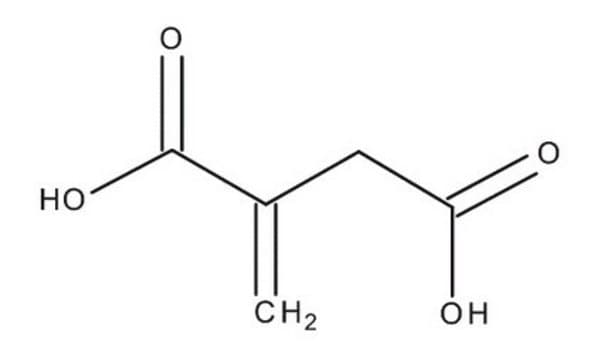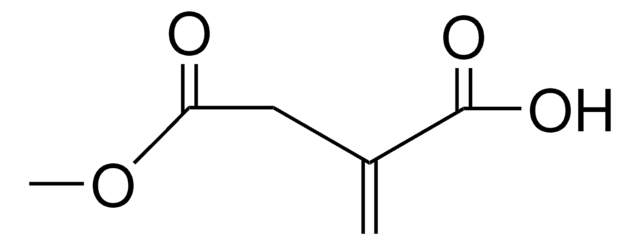I29204
Itaconic acid
≥99%
Synonym(s):
Methylenesuccinic acid
Sign Into View Organizational & Contract Pricing
All Photos(3)
About This Item
Linear Formula:
HO2CCH2C(=CH2)CO2H
CAS Number:
Molecular Weight:
130.10
Beilstein:
1759501
EC Number:
MDL number:
UNSPSC Code:
12352100
PubChem Substance ID:
NACRES:
NA.22
Recommended Products
Assay
≥99%
autoignition temp.
1472 °F
mp
165-168 °C (lit.)
density
1.573 g/mL at 25 °C (lit.)
SMILES string
OC(=O)CC(=C)C(O)=O
InChI
1S/C5H6O4/c1-3(5(8)9)2-4(6)7/h1-2H2,(H,6,7)(H,8,9)
InChI key
LVHBHZANLOWSRM-UHFFFAOYSA-N
Looking for similar products? Visit Product Comparison Guide
Application
Itaconic acid (IA) can be used:
- As a comonomer in the polymerization of polyacrylonitrile (PAN) to promote the thermo-oxidative stabilization of polymer.
- In combination with acrylamide to form (poly[acrylamide-co-(itaconicacid)]) to synthesize biodegradable superabsorbent polymers.
- To synthesize biobased polyester composite in fabric industry.
Signal Word
Danger
Hazard Statements
Precautionary Statements
Hazard Classifications
Eye Dam. 1
Storage Class Code
11 - Combustible Solids
WGK
WGK 1
Personal Protective Equipment
dust mask type N95 (US), Eyeshields, Gloves
Certificates of Analysis (COA)
Search for Certificates of Analysis (COA) by entering the products Lot/Batch Number. Lot and Batch Numbers can be found on a product’s label following the words ‘Lot’ or ‘Batch’.
Already Own This Product?
Find documentation for the products that you have recently purchased in the Document Library.
Customers Also Viewed
Mechanism and kinetics of the stabilization reactions of itaconic acid-modified polyacrylonitrile
Ouyang Q, et al.
Polymer Degradation and Stability, 93(8), 1415-1421 (2008)
Graft copolymerization, characterization, and degradation of cassava starch-g-acrylamide itaconic acid superabsorbents
Lanthong P, et al.
Carbohydrate Polymers, 66(2), 229-245 (2006)
Selective and flexible transformation of biomass-derived platform chemicals by a multifunctional catalytic system.
Frank M A Geilen et al.
Angewandte Chemie (International ed. in English), 49(32), 5510-5514 (2010-06-30)
Reddithota J Krupadam et al.
Environmental science and pollution research international, 19(5), 1841-1851 (2011-12-31)
Microcystins (MCs; cyclic heptapeptides) are produced by freshwater cyanobacteria and cause public health concern in potable water supplies. There are more than 60 types of MCs identified to date, of which MC-LR is the most common found worldwide. For MC-LR
Fully Biobased Composites of an Itaconic Acid Derived Unsaturated Polyester Reinforced with Cotton Fabrics
Dai Z, et al.
ACS sustainable chemistry & engineering, 6(11), 15056-15063 (2018)
Our team of scientists has experience in all areas of research including Life Science, Material Science, Chemical Synthesis, Chromatography, Analytical and many others.
Contact Technical Service












